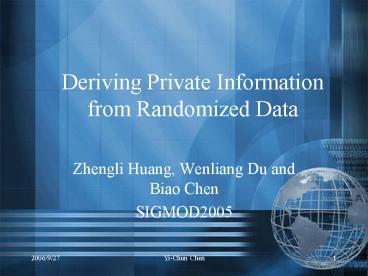Deriving Private Information from Randomized Data - PowerPoint PPT Presentation
1 / 22
Title:
Deriving Private Information from Randomized Data
Description:
First PC: containing the greatest amount of variation. ... Then more dimensions can be reduced without causing too much information loss ... – PowerPoint PPT presentation
Number of Views:28
Avg rating:3.0/5.0
Title: Deriving Private Information from Randomized Data
1
Deriving Private Information from Randomized Data
- Zhengli Huang, Wenliang Du and Biao Chen
- SIGMOD2005
2
Outline
- Motivation
- Reconstruction Algorithms
- Improve Random Perturbation
- Conclusion
3
Privacy-Preserving Data Mining
Classification Association Rules Clustering
Data Mining
Central Database
Data Collection
Data Disguising
4
Random Perturbation
Original Data X
Random Noise R
Disguised Data Y
5
Problem
- How secure is Randomization Perturbation?
6
Example
- This is the data set (x, x, x, x, x, , x)
- Random Perturbation
- (xr1, xr2,, xrm)
- rt is random number with mean 0
- So the perturbation numbers mean converges to x,
when m becomes large. - We know this is NOT safe.
- Observation the data set is highly correlated.
7
Summary
- We assume that the relationships among data
attributes might be the key factor that decides
how much privacy can be preserved. - We introduce two methods that exploit the
correlations among data to reconstruct the
original data from a randomized data set.
8
Data Reconstruction (DR)
Distribution of random noise
Reconstructed Data X
Data Reconstruction
Whats their difference?
Disguised Data Y
Original Data X
9
Reconstruction Algorithms
- Principal Component Analysis (PCA)
- Bayes Estimate Method (BE)
10
PCA-Based Reconstruction
Disguised Information
Reconstructed Information
compression
Information Loss
11
PCA Introduction
- The main use of PCA reduce the dimensionality of
a data set with interrelated variables, but still
contain as much variance of the data set as
possible - PCA can transform the data set to a new data set
with variables, which are uncorrelated
12
PCA Introduction
- First PC containing the greatest amount of
variation. - Second PC containing the next largest amount of
variation.
13
For the Original Data
- They are correlated.
- If we remove 50 of the dimensions, the actual
information loss might be less than 10. - If the rest m-p non-PCs remove, it do not cause
much information loss.
14
For the Random Noises
- They are not correlated.
- Their variance is evenly distributed to any
direction. - The information loss for the noise increases.
15
Summary
- If the data is highly correlated
- Then more dimensions can be reduced without
causing too much information loss for the
original data.
16
Bayes-Estimate-Based Reconstruction
Possible X
Possible X
Possible X
What is the Most likely X?
Random Noise
Disguised Data Y
17
The Problem Formulation
- For each possible X, there is a probability P(X
Y). - Find an X, s.t., P(X Y) is maximized.
- How to compute P(X Y)?
18
Computing P(X Y)?
- P(XY) P(YX) P(X) / P(Y)
- P(YX) remember Y X R
- P(Y) A constant (we dont care)
- How to get P(X)?
- This is where the correlation can be used.
- Assume Multivariate Gaussian Distribution
- The parameters are unknown.
19
Multivariate Gaussian Distribution
- A Multivariate Gaussian distribution
- Each variable is a Gaussian distribution with
mean ?i - Mean vector ? (?1 ,, ?m)
- Covariance matrix ?
- Both ? and ? can be estimated from Y
- So we can get P(X)
20
Improved Randomization Scheme
- From the analysis of PCA
- While most of the information of the original
data concentrates on the PC, we discard those
non-PCs, we can remove more noises than what we
do to the original data. - However, if random noises also concentrate on the
PCs, separating original data from random noises
becomes difficult.
21
Observation from PCA
- How to make it difficult to squeeze out noise?
- Noise now concentrates on the principal
components. - Make the correlation of the noise similar to the
original data.
22
Conclusion
- Can other information affect privacy?































